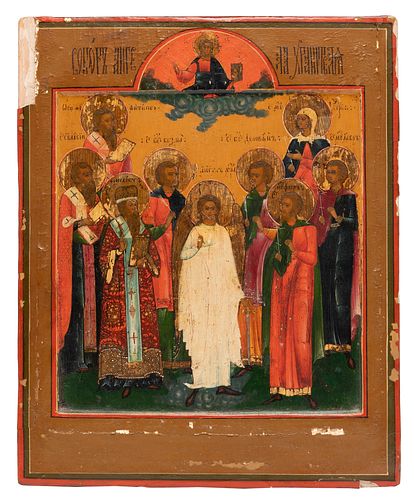Russian school, workshops of the Old Believers, 19th century. "Guardian Angel with selected saints". Tempera on panel.
Lot 118
About Seller
Setdart Auction House
Carrer Aragó 346
Barcelona
Spain
Setdart Subastas was born in 2004 and is currently the first online art auction in Spain with solidity, prestige and reliability guaranteed by our more than 60,000 users. Setdart has a young, dynamic and enterprising team ready to successfully manage the purchase and sale of art works through custom...Read more
Estimate:
EUR€700 - EUR€800
$714.29 - $816.33
Absentee vs Live bid
Two ways to bid:
- Leave a max absentee bid and the platform will bid on your behalf up to your maximum bid during the live auction.
- Bid live during the auction and your bids will be submitted real-time to the auctioneer.
Bid Increments
| Price | Bid Increment |
|---|---|
| EUR€0 | EUR€10 |
| EUR€200 | EUR€25 |
| EUR€500 | EUR€50 |
| EUR€1,000 | EUR€100 |
| EUR€3,000 | EUR€200 |
| EUR€5,000 | EUR€500 |
| EUR€10,000 | EUR€1,000 |
| EUR€20,000 | EUR€2,000 |
| EUR€50,000 | EUR€5,000 |
About Auction
By Setdart Auction House
Nov 3, 2021
Set Reminder
2021-11-03 08:00:00
2021-11-03 08:00:00
America/New_York
Bidsquare
Bidsquare : OLD MASTERS
https://www.bidsquare.com/auctions/setdart-auction-house/old-masters-7786
Setdart Auction House sofia@setdart.com
Setdart Auction House sofia@setdart.com
- Lot Description
Russian school, workshops of the Old Believers, 19th century. "Guardian Angel with selected saints". Tempera on panel. Measurements: 36 x 28,5 cm. The icon of interest represents a composition of several saints and martyrs, surrounding the figure of the Guardian Angel. The latter can be recognized by the inscription, located above his nimbus and by certain iconographic characteristics, such as the white chiton, the wings, the sword and the cross. The icon is made with a palette of saturated colors, and with very concentrated pigments. The typology of the saints, with the blessing with two fingers, in addition to the inscriptions with the specific characteristics, and the name of Jesus Christ as "IC XC", indicates that it is a piece made in the workshops of the ancient believers. When talking about the iconography of the Guardian Angels, it should be noted that it is a very complex and controversial field of Christian painting. Even today there are debates about whether there is a place in traditional Christian iconography for representations of Guardian Angels, since any figurative representation of these beings contradicts the pre-established dogmas. In the Roman catacombs there are already images of angels, although without the usual wings. However, in the first Christian monuments there are no images of the Guardian Angel. His iconography, spread in Russia from the XVI-XVII centuries, usually presents a young man dressed in white chiton, sometimes with tunic and himation, or mantle, and his main attributes are a cross and a naked sword, as the symbol of the protection of the throne of God. Most of the icons that can be found of the Guardian Angels, either representations of the angels alone, or with one or several saints, are modern icons. The controversy about the representation of these celestial beings is deeply philosophical and theosophical. It is because, according to the scriptures, their form and appearance is unknown to mortals. A mortal can see his Guardian Angel, only when his soul is separated from the body, that is to say after death. So, in depicting the Guardian Angels, the painter should have died and then resurrected. In the case that the painter happens to have been resurrected, the form he will give to the Guardian Angel will have nothing to do with his real appearance, since it will only be based on the painter's memory and imagination. Which, consequently, causes other debates. One, regarding the role of the painter of the icons, which a priori should remain unnoticed, that is, should not be given any prominence, since the main protagonist is the saint represented. And another, in relation to the very appearance of the Angel, since he will not have, or will have, a unified appearance for all mortals. Whatever the answer and one's position on this long-standing iconographic debate, the representations of the Guardian Angels always remind one of the philosophical and logical facet of religion. Moreover, such icons reinforce the Christian religion as a living field open to diverse iconographic interpretations, despite traditional dogmas.
- Shipping Info
-
In-house shipping available. Please inquire at admin@setdart.com.
-
- Buyer's Premium



 EUR
EUR CAD
CAD AUD
AUD GBP
GBP MXN
MXN HKD
HKD CNY
CNY MYR
MYR SEK
SEK SGD
SGD CHF
CHF THB
THB















